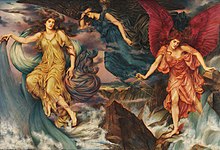De Morgan Foundation
The son of a mathematician father and social reform campaigner mother, William was raised in a liberal household which instilled socialist ideals in him from a young age.
For four years he drew rigorous studies of antique casts, growing gradually disillusioned with the institution.
He escaped urban London with designs of medieval flowers, and Islamic foliage and rejected gritty realism in favour of creating fantastical beasts, emblazoning his tiles with unicorns, sea monsters, fauns and mermaids.
With the help of her Pre-Raphaelite uncle, John Roddam Spencer Stanhope, she trained at the Slade School of Art and travelled through Italy and France sketching from the Old Masters, Botticelli and Mantegna.
Evelyn had propped up the failing ceramics business with around £4,000 of her personal wealth, but had been permitted to pursue her own career rather than become a ‘angel of the home’ turning gender roles of the time upside down.
Together, in 1909, they anonymously published The Result of an Experiment, a collection of the conversations they recorded with spirits of the departed in their automatic writing sessions.
William’s career had peaked with his work in achieving the perfect metallic lustre glaze, an ancient technique he had reinvented to high acclaim.
The collection was formed by Evelyn De Morgan’s sister, Mrs. Wilhelmina Stirling, a supporter of the ideals of the Pre-Raphaelite Brotherhood, who also wrote several books under the name A.M.W.
Following her sister’s death in 1919, she had to battle with their brother Spencer, the executor of the De Morgan estate, to buy paintings from Evelyn’s studio which he saw as ‘refuse’, not good enough.
Her relentless collecting forced her and her husband to relocate in 1931 to Old Battersea House, a Georgian mansion in South West London.
Both William (1839-1917) and Evelyn (1855-1919) De Morgan were artists when they married in 1887, and in addition to their art they became involved in many of the leading issues of the day including the suffrage movement, prison reform, pacifism, and spiritualism.
is an exhibition that juxtaposes William and Mary’s exclusive interest in the decorative elements of Islamic art for their unique designs, with Evelyn and George’s deep concern for symbolic motifs that would convey their political messages.
Wightwick Manor, Wolverhampton, is a house built to Oscar Wilde’s principles of the aesthetic interior and filled with De Morgan tiles and artworks.



